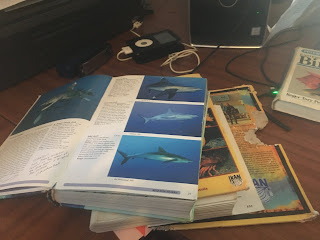My first ever book was this one:
My dad had a copy of this book and I loved looking at the little thumbnail maps. It showed if the bird was a year-round resident or a summer visitor. I found it essential when looking for information.
When I no longer lived at home, it is one of the first books I bought. I used it often.
During one careless camping trip to Lake Superior, I left it out on the picnic table over night. It got wet and the pages stuck together. I cursed my thoughtlessness and tried to dry the book carefully. Because the paper had a shiny finish, it made the pages stick together if they were not separated during the drying process. I remember putting leaves of toilet paper between each page to prevent the book from becoming an unusable brick of paper. In the end I think I bought a new copy.
I wish I had kept that damaged book, because I write notes in the margins. I had kept a list of birds that I have seen. I am sure that now I will have forgotten that I have seen some of those birds. I have a few notes in the margins of this copy. Maybe it was beyond help.
My eldest son now lives in Portland, Oregon and he had a hummingbird at his feeder this week. A hummingbird in November is worthy of looking up. With minimum research, I discovered that there is a resident and year round population of Anna's hummingbirds living in Portland. Dashing for my book of North American birds I discovered that my beloved book is only for Eastern birds. Portland is firmly on the West coast. Different bird populations and a completely different field guide is needed.
Here's the thing. . . I don't live in Portland, Oregon in the Pacific NW of America. I live here in Scotland. Do I get myself a field guide for birds of Western Birds? I'll only be there two weeks. Of course I'll be visiting from time to time to spend time with my son and his family. I may get one. . . . I can add it to the field guide section of my library.
These are my field guides to things (fish, coral, seashells, turtles etc) in the Red Sea. I do actually need both field guides. There are some animals in one book that are not in the other. I have discovered over the years that I use both.
As you can see, I still write notes in the margins. Also obvious is the damage of one of the books. A rescue dog that we had here for a short time, ripped the book up. It is still quite usable. I am just going to tape it up and carry on.













